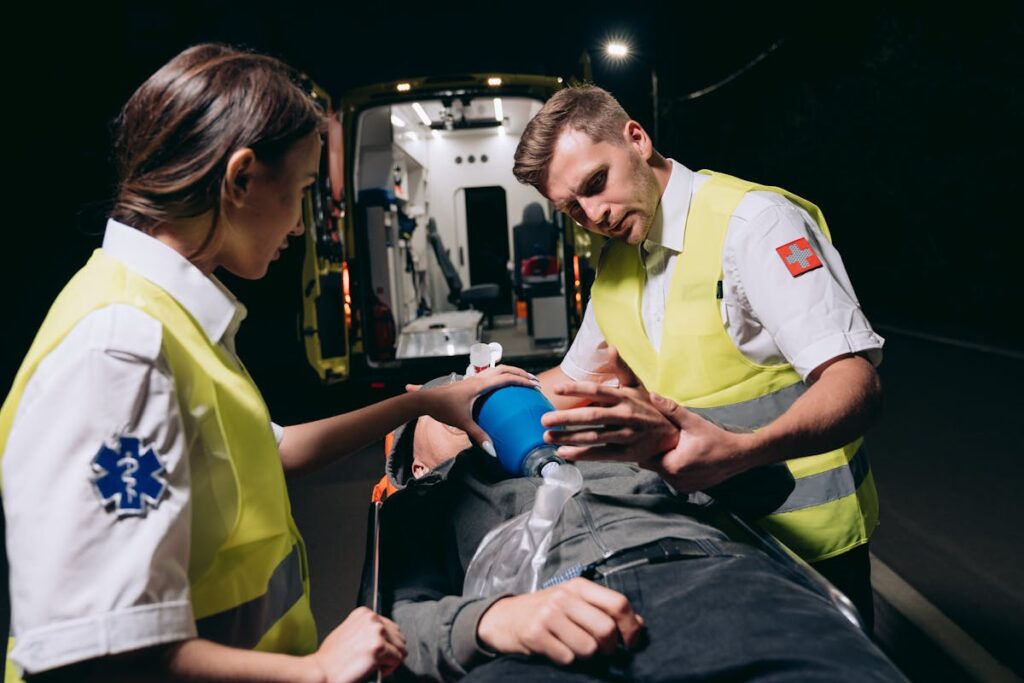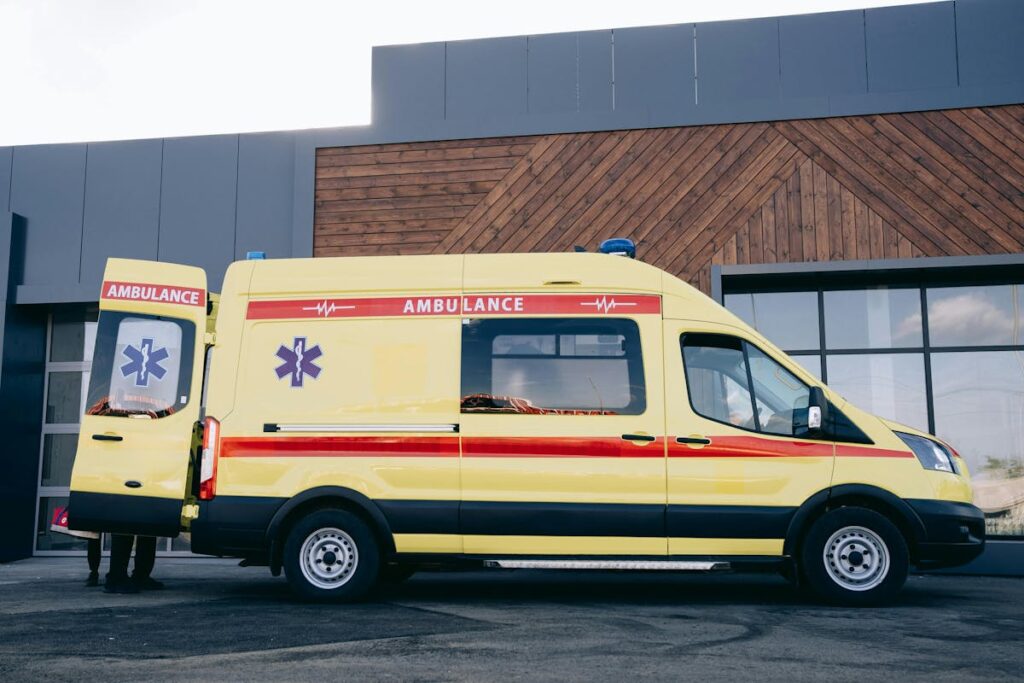The evolution of emergency response to car accidents has markedly improved the speed and precision of first responders. Through the integration of real-time communication networks and automated crash detection systems, data sharing is streamlined, enabling rapid assessment and customized medical interventions. These advancements, coupled with AI-driven traffic management and telemedicine in ambulances, elevate situational awareness and patient care. As technology continues to advance, these innovations offer promising potential for further improvements in road safety and accident response.
Real-Time Communication Networks
Real-time communication networks have revolutionized the efficiency and effectiveness of emergency response to car accidents. These networks facilitate immediate real-time data sharing between first responders, hospitals, and other critical entities. The availability of instant data exchange guarantees that accident scenes are assessed rapidly, allowing for timely medical intervention. Network reliability is paramount, guaranteeing that communication is uninterrupted and accurate, thereby minimizing response times and potential fatalities. By maintaining robust connectivity, these networks support the seamless transmission of essential information such as vehicle location, passenger details, and accident severity. Consequently, emergency services can tailor their responses based on precise and current data. The integration of real-time communication networks into emergency protocols underscores a significant advancement in managing vehicular accidents efficiently.
Automated Crash Detection Systems
Automated crash detection systems have revolutionized emergency response by providing real-time alert notifications, greatly reducing response times. These systems are designed to automatically contact emergency services upon detecting a collision, thereby streamlining the integration between accident sites and first responders. Through precise data transmission, such systems enhance situational awareness and facilitate immediate action, potentially mitigating the severity of injuries and fatalities.
Real-Time Alert Notifications
Recent advancements in vehicle technology have led to the development of sophisticated crash detection systems that facilitate real-time alert notifications. These systems employ state-of-the-art sensors and algorithms to detect collisions with remarkable accuracy. Upon crash detection, notification systems are triggered, dispatching instant alerts to predefined contacts through emergency apps. This immediate communication enhances the timeliness of help, potentially mitigating injury severity. Emergency apps embedded within these systems allow for automated transmission of critical incident data, such as location and crash severity, enhancing situational awareness for responders. The precision and speed of these notifications are pivotal in reducing response times. Analytical data gathered from such systems also contribute to improving the overall design and functionality of future notification systems.
Integration With Emergency Services
By seamlessly integrating with emergency services, automated crash detection systems enhance the efficiency and effectiveness of post-accident response protocols. These systems utilize advanced sensors and algorithms to detect collisions in real-time, instantly transmitting critical data to emergency responders. The integration fosters collaborative protocols, ensuring that accurate information, such as location and severity of the accident, is swiftly communicated. This precise data transmission enables emergency services to optimize resource allocation, deploying the appropriate personnel and equipment to the scene promptly. The synchronization between crash detection systems and emergency services minimizes response times, potentially reducing fatalities and injuries. Consequently, this technological advancement serves as a pivotal component in modernizing emergency response strategies, promoting faster, more informed decision-making in critical situations.
Advanced GPS and Mapping Technologies
Leveraging advanced GPS and mapping technologies has greatly enhanced the efficiency and effectiveness of emergency response to car accidents. These systems provide precise mapping accuracy, enabling responders to pinpoint accident locations with remarkable precision. The integration of state-of-the-art navigation systems guarantees rapid deployment of emergency services, minimizing response times. Enhanced accuracy in mapping allows for better coordination among responders, optimizing routing and reducing potential delays.
Moreover, real-time data integration offers vital insights into traffic conditions, enabling emergency personnel to anticipate and circumvent obstructions. The use of these technologies has considerably improved situational awareness, thereby increasing the chances of timely medical intervention. Overall, the adoption of advanced GPS and mapping systems plays an essential role in optimizing emergency response strategies, ultimately saving lives.
Drone-Assisted Emergency Response
The deployment of drones in emergency response to car accidents introduces a transformative capability in rapid assessment and resource allocation. Utilizing drone logistics, these unmanned aerial vehicles (UAVs) can swiftly navigate congested roadways, providing critical real-time data to first responders. Aerial surveillance offers an extensive overhead view of accident scenes, enhancing situational awareness and enabling precise decision-making. This technology facilitates the identification of hazards, victim locations, and traffic obstructions, thereby optimizing the dispatch of emergency services. In addition, drones can deliver essential supplies, such as medical kits or communication devices, directly to the site. By integrating drone capabilities into emergency response frameworks, agencies can considerably reduce response times and improve outcomes, ultimately saving lives and resources in acute scenarios.
Telemedicine Integration in Ambulances
The integration of telemedicine in ambulances enables real-time medical consultations that enhance decision-making during emergency responses to car accidents. Equipped with remote diagnostic equipment, paramedics can transmit crucial patient data to specialists who provide immediate guidance for critical interventions. This approach not only improves patient outcomes but also optimizes the use of emergency medical resources.

Real-time Medical Consultations
As the integration of telemedicine in ambulances progresses, emergency response teams gain the capability for real-time medical consultations during transit to the hospital. This advancement allows paramedics to engage in remote consultations with physicians, facilitating immediate access to medical expertise. By aligning with established emergency protocols, these consultations guarantee that critical decisions are made swiftly and accurately. The system enables a seamless exchange of patient information, allowing physicians to guide paramedics in administering precise pre-hospital care. Consequently, it enhances the timeliness and quality of medical interventions, potentially reducing morbidity and mortality rates in car accident victims. This integration represents a significant stride in emergency care, combining technological innovation with clinical acumen to optimize patient outcomes during critical transit periods.
Remote Diagnostic Equipment
Many ambulances are now equipped with remote diagnostic equipment as part of the telemedicine integration initiative. This advancement greatly enhances diagnostic accuracy during emergency responses to car accidents. By providing real-time data transmission, these devices allow for immediate analysis by medical professionals who are not physically present at the scene. The portability of the equipment is essential, ensuring that it can be easily used within the confined space of an ambulance. Portable devices include electrocardiograms, ultrasound machines, and other monitoring systems capable of transmitting important signs and other critical health indicators. The integration of such technology facilitates timely decision-making, potentially improving patient outcomes by allowing pre-hospital intervention strategies to be tailored more effectively based on accurate and immediate diagnostic information.
AI-Powered Traffic Management
In recent years, AI-powered traffic management systems have emerged as pivotal tools in enhancing the efficiency and effectiveness of emergency response to car accidents. These systems employ advanced traffic pattern analysis to discern real-time road conditions, enabling swift identification of accident-prone zones. Utilizing predictive modeling, they forecast potential accident hotspots, allowing authorities to preemptively adjust traffic flow and deploy resources more effectively. This technology facilitates rapid clearance routes for emergency vehicles, minimizing response times and improving outcomes for accident victims. Integrating AI into traffic management frameworks markedly optimizes routing decisions, reduces congestion, and enhances overall traffic safety. Consequently, the deployment of AI-driven strategies in traffic management represents a notable advancement in the field of emergency response to vehicular incidents.
Enhanced First Responder Training Programs
While AI-driven traffic management systems enhance logistical efficiency in emergency responses, the human element remains critical in addressing car accidents effectively. Enhanced first responder training programs focus on scenario based training, which equips personnel with the skills to handle diverse accident scenarios. These programs leverage simulation exercises to replicate real-world conditions, providing responders with hands-on experience. The integration of technology in these exercises allows responders to develop critical thinking and adaptability in high-pressure situations. Additionally, scenario based training guarantees that responders can anticipate potential complications and make informed decisions promptly. The use of advanced simulation exercises serves to bridge the gap between theoretical knowledge and practical application, ultimately improving the overall efficacy of emergency response teams in car accident situations.
Vehicle-to-Infrastructure Communication
As technology continues to evolve, vehicle-to-infrastructure (V2I) communication emerges as a vital component in enhancing road safety and efficiency during emergencies. This system enables vehicles to exchange real-time data with surrounding infrastructure, such as traffic signals and roadside sensors. Implementing stringent vehicle interoperability standards is essential to guarantee seamless communication between diverse vehicle and infrastructure systems. This integration allows for precise coordination in emergency situations, reducing response times and minimizing traffic congestion.
Infrastructure upgrades are fundamental to support V2I systems, requiring investment in smart technology and robust communication networks. These upgrades facilitate automatic rerouting of traffic, prioritization of emergency vehicles, and dissemination of critical information to drivers. Consequently, V2I communication represents a significant advancement in the management of car accident emergencies.
Wearable Technology for Victim Monitoring
Amidst the growing focus on improving emergency response systems, wearable technology emerges as an important tool for monitoring accident victims. Wearable sensors provide real-time health data, allowing for prompt and informed medical intervention. These devices can track key signs such as heart rate, blood pressure, and oxygen levels, transmitting critical information to medical personnel en route to the accident site. The ability to continuously monitor these parameters guarantees a more accurate assessment of victim status and needs. In addition, seamless integration of this technology with emergency response systems facilitates immediate data sharing. This synergy enhances decision-making and resource allocation. As wearable technology advances, its role in emergency response will likely expand, improving outcomes for individuals involved in vehicular accidents.
Frequently Asked Questions
How Can Bystanders Assist Before Emergency Personnel Arrive?
Bystanders can assist by administering first aid and following emergency protocols, such as calling emergency services, securing the scene, and providing basic care to victims, ensuring minimal movement to prevent further injury until professionals arrive.
What Role Do Insurance Companies Play in Emergency Response Advancements?
Insurance companies play a pivotal role in emergency response advancements by leveraging insurance technology to streamline claims processing and offering policy incentives that encourage the adoption of safety innovations, ultimately enhancing overall response efficiency and reducing accident impact.
How Are Emergency Response Advancements Funded?
Funding for emergency response advancements involves grant funding from governmental bodies and non-profit organizations, alongside investments through public-private partnerships, facilitating resource allocation, technology development, and training to enhance overall effectiveness and efficiency in emergency management.
What Privacy Concerns Arise With New Emergency Technologies?
The current question examines privacy concerns associated with emerging technologies, specifically focusing on data tracking and consent issues. Increased data collection raises potential risks, necessitating stringent privacy policies to guarantee individuals’ personal information is handled responsibly and securely.
How Do Cultural Differences Impact Emergency Response Strategies?
Cultural perceptions shape emergency response strategies, influencing response effectiveness. Variations in communication styles, trust in authorities, and societal norms necessitate tailored approaches to maximize efficiency and acceptance in diverse cultural contexts, ensuring ideal outcomes in emergency situations.

